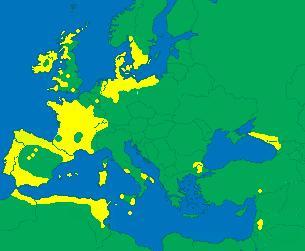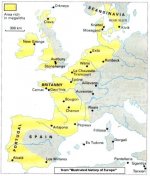I have hypothesised for several years that the wave of Neolithic farmers who came from the southern Levant through North Africa brought a quite different set of haplogroups and autosomal admixture than the Anatolian farmers that colonised the Balkans and Central Europe.
There is ample archaeological evidence that megaliths originated in the southern Levant (Israel) and Egypt and spread via the south coast of the Mediterranean to Malta, Andalusia (La Almagra Pottery culture) and southern Portugal (Algarve), then spread north along the Atlantic coast of Europe to Brittany, the British Isles, and east to inland France, Corsica, Germany, Belgium and Denmark.
I noticed that samples from the Funnelbeaker culture in Scandinavia, which was a Megalithic culture, had an inordinate amount of Sub-Saharan African autosomal DNA. That made me wonder how it could have got there. My explanation was that it came from Iberian Megalithic people, who in turn got it from Neolithic farmers from North Africa.
As the phylogenetic trees of Y-haplogroups are getting deeper year after year, it is becoming easier to retrace ancient migrations.
Y-DNA haplogroups
In my opinion, these farmers belonged to Y-haplogroups T1a, R1b-V88, E1b1b, and a few specific G2a and J1 subclades.
Haplogroup T1a was found in Pre-Pottery Neolithic Jordan. Its expansion age dates from the Early Neolithic and its modern distribution in the Middle East suggests a stronger association with the Fertile Crescent and Southwest Asia than with Anatolia. After analysing the T1a phylogeography, it struck me that the subclades dating from the Neolithic that were found in Europe were also typically found in the Arabian peninsula and sometimes also East and North Africa. This is the case of T1a1a1a1-CTS2214 (found in Southwest Asia, East Africa and western Europe), T1a1a1b1-Y12643 (found in the Arabian peninsula and western Europe), and T1a1a1b2-Y22559 (found in North Africa and Iberia). Considering that only two T1a samples were so far found in Neolithic Europe (both from LBK Germany), there is a good chance that most T1a followed a different route than the Anatolian one taken by predominantly G2a farmers.
Haplogroup R1b-V88 is found in the Levant, most of Africa as well as western Europe. Its presence has been confirmed in Neolithic Spain, although it was never found in the Neolithic Balkans or Central Europe, nor in Mesolithic Europe. All the data strongly supports a Neolithic diffusion from the southern Levant to North Africa, Iberia, then western Europe.
Haplogroup E1b1b was the main lineage of the Natufians (Mesolithic southern Levant). They might have carried a mix of E-V123, E-Z827 and E-M78. Levantine Neolithic farmers would undoubtedly have carried this lineage when they colonised North and East Africa, although it very likely that E1b1b was already present on both sides of the Red Sea before the Neolithic. A small minority of Western Europeans carry E-V12 and E-V22 lineages (under M78), which could be of Neolithic origin. Likewise, E-M123 could have spread through North Africa to Western Europe, as well as again later (Bronze and Iron Ages) from the Near East to Greece and Italy.
All Near Eastern Neolithic farmers probably carried at least some haplogroup G2a. Ancient DNA test showed that Anatolian farmers who colonised the Balkans belonged chiefly to G2a2b (L30), which is the biggest branch in Europe today, as well as G2a2a1b (L90). However, the G2a2a1a-M286 branch hasn't been found in Neolithic samples yet, and today it is present mostly in the Middle East and western Europe, but apparently not in between. This suggests that it could have been a minority lineage of South Levantine farmers.
Haplogroup J1 most probably originated around the Caucasus. Its phylogeography shows that some early branches (like J1b) might have migrated to Europe before the Neolithic. Others spread with Neolithic farmers from the northern Middle East to Europe (L1189). More interestingly, one branch (PF7264) also expanded during the Neolithic, but is found today in the Arabian peninsula, East Africa and western Europe (Italy, Germany, Britain). This is another potential candidate for Neolithic migration along the southern Mediterranean route to Iberia, although that would be the least certain in the list.
Mitochondrial haplogroups
In terms of mtDNA, the Southwest Asian farmers would have carried typical Near Eastern farmers like haplogroups H5, K1a and T1a, but also other more specific to North Africa and Iberia like J2a2, X1, X2b and X3.
I attempted to determine in this thread other lineages associated with Southwest Asian farmers and came up with mt-haplogroups M1, N1, R0, HV and U3. The Southwest Asian farmers would have absorbed other lineages in Northwest Africa before reaching the Iberian peninsula. These would surely have included U6, and perhaps also H1, H3, H4 and HV0/V.
There is ample archaeological evidence that megaliths originated in the southern Levant (Israel) and Egypt and spread via the south coast of the Mediterranean to Malta, Andalusia (La Almagra Pottery culture) and southern Portugal (Algarve), then spread north along the Atlantic coast of Europe to Brittany, the British Isles, and east to inland France, Corsica, Germany, Belgium and Denmark.
I noticed that samples from the Funnelbeaker culture in Scandinavia, which was a Megalithic culture, had an inordinate amount of Sub-Saharan African autosomal DNA. That made me wonder how it could have got there. My explanation was that it came from Iberian Megalithic people, who in turn got it from Neolithic farmers from North Africa.
As the phylogenetic trees of Y-haplogroups are getting deeper year after year, it is becoming easier to retrace ancient migrations.
Y-DNA haplogroups
In my opinion, these farmers belonged to Y-haplogroups T1a, R1b-V88, E1b1b, and a few specific G2a and J1 subclades.
Haplogroup T1a was found in Pre-Pottery Neolithic Jordan. Its expansion age dates from the Early Neolithic and its modern distribution in the Middle East suggests a stronger association with the Fertile Crescent and Southwest Asia than with Anatolia. After analysing the T1a phylogeography, it struck me that the subclades dating from the Neolithic that were found in Europe were also typically found in the Arabian peninsula and sometimes also East and North Africa. This is the case of T1a1a1a1-CTS2214 (found in Southwest Asia, East Africa and western Europe), T1a1a1b1-Y12643 (found in the Arabian peninsula and western Europe), and T1a1a1b2-Y22559 (found in North Africa and Iberia). Considering that only two T1a samples were so far found in Neolithic Europe (both from LBK Germany), there is a good chance that most T1a followed a different route than the Anatolian one taken by predominantly G2a farmers.
Haplogroup R1b-V88 is found in the Levant, most of Africa as well as western Europe. Its presence has been confirmed in Neolithic Spain, although it was never found in the Neolithic Balkans or Central Europe, nor in Mesolithic Europe. All the data strongly supports a Neolithic diffusion from the southern Levant to North Africa, Iberia, then western Europe.
Haplogroup E1b1b was the main lineage of the Natufians (Mesolithic southern Levant). They might have carried a mix of E-V123, E-Z827 and E-M78. Levantine Neolithic farmers would undoubtedly have carried this lineage when they colonised North and East Africa, although it very likely that E1b1b was already present on both sides of the Red Sea before the Neolithic. A small minority of Western Europeans carry E-V12 and E-V22 lineages (under M78), which could be of Neolithic origin. Likewise, E-M123 could have spread through North Africa to Western Europe, as well as again later (Bronze and Iron Ages) from the Near East to Greece and Italy.
All Near Eastern Neolithic farmers probably carried at least some haplogroup G2a. Ancient DNA test showed that Anatolian farmers who colonised the Balkans belonged chiefly to G2a2b (L30), which is the biggest branch in Europe today, as well as G2a2a1b (L90). However, the G2a2a1a-M286 branch hasn't been found in Neolithic samples yet, and today it is present mostly in the Middle East and western Europe, but apparently not in between. This suggests that it could have been a minority lineage of South Levantine farmers.
Haplogroup J1 most probably originated around the Caucasus. Its phylogeography shows that some early branches (like J1b) might have migrated to Europe before the Neolithic. Others spread with Neolithic farmers from the northern Middle East to Europe (L1189). More interestingly, one branch (PF7264) also expanded during the Neolithic, but is found today in the Arabian peninsula, East Africa and western Europe (Italy, Germany, Britain). This is another potential candidate for Neolithic migration along the southern Mediterranean route to Iberia, although that would be the least certain in the list.
Mitochondrial haplogroups
In terms of mtDNA, the Southwest Asian farmers would have carried typical Near Eastern farmers like haplogroups H5, K1a and T1a, but also other more specific to North Africa and Iberia like J2a2, X1, X2b and X3.
I attempted to determine in this thread other lineages associated with Southwest Asian farmers and came up with mt-haplogroups M1, N1, R0, HV and U3. The Southwest Asian farmers would have absorbed other lineages in Northwest Africa before reaching the Iberian peninsula. These would surely have included U6, and perhaps also H1, H3, H4 and HV0/V.





